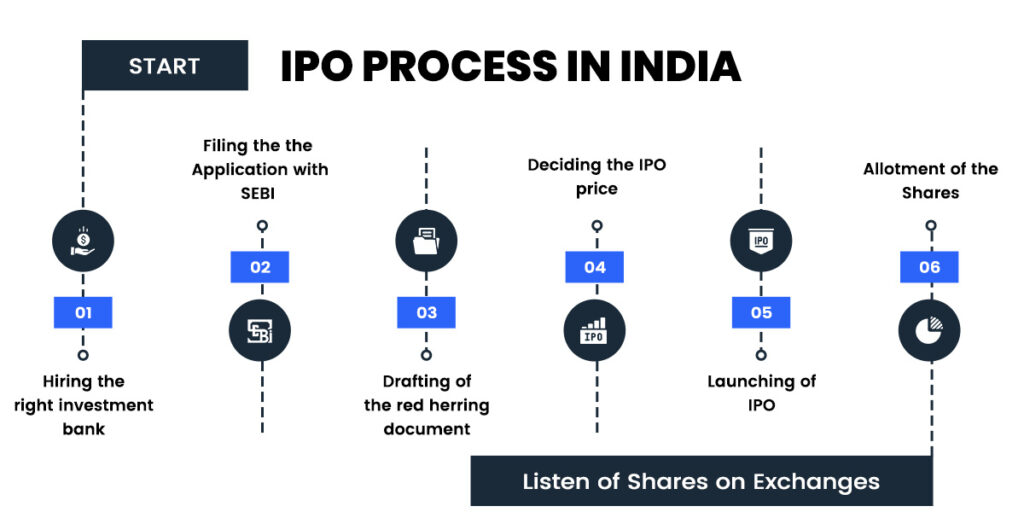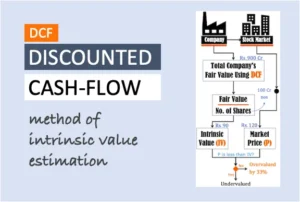
Baics of iPO
What is Initial public offer {IPO}
IPO is a way/ process by which a company issue his shares for the very first time in public. simply IPO is a process by which general public can buy shares of a particular company for first time
Why IPO is needed for companies
At a certain point of time company needs massive funds for growth, product chain expansion, for installing new technology for business etc. at that time venture capital, angel investors and private equity firms are not able to fund them so them raise funds from general public and institutional investors {Mutual funds and pension funds etc.} through IPO.
Eligibility for an IPO
- They have at- least 10 crores paid up capital means they have to collect minimum 10 crore from public through IPO
- They have at- least 25 crore market capitalization after completing IPO
- They have to book profits for consecutive 3 years before launch its IPO

Advantages
- Publicity – When a company launch his IPO every investor and market researcher discuss about them through which company gain immense publicity because everyone talks about their products/ services, goals, and ambitions.
- Raise immense funds – When a company launch its IPO, they raised immense funds that they can use in different areas like installing new technology, paying debts, expand product chain and for expand business rapidly.
- Reduce debts – Sometime company launch its IPO in order to reduce some proportion of debts and improve company financial health
Disadvantages –
- Regulation Cost – when a company decide to become there is an immense cost related to paperwork and arrangement of other stuff related to regulatory body like hiring investment bank, promotion in general public etc.
- Pressure from general public – When a company become public it receives immense pressure from public because company have to perform in short term no matter how they perform in long term
- Lack of transparency – When a company become public, they have to talk about their strategy, competitive edge, business model and publish their financial reports in every quarter so these companies lack transparency.
Process of IPO
Let us learn the process of IPO with the given below chart for better understanding

As you can see the chart let us understand it deeply
Hiring the Investment bank
Every famous bank {like Axis bank, SBI and ICICI bank} all have their investment bank branch to help companies to launch their IPO
Things a company see before hire a particular investment bank –
1 Reputation of the investment bank
2 What the method they used for valuation of a company
3 How they advertise company
Due diligence and filling
After hiring an investment bank next step is to complete all formalities and paperwork related to company IPO let us understand them one by one

Underwriting
This is an assistance and assurance provided by the investment bank if any company does not achieve the required subscription, then bank buy rest shares, and it called underwriting.
- Let take an example to understand it
| Anil CO. LTD. | |
| Issued shares | 1000000 |
| Subscribed shares | 9000000 |
| Un – subscribed shares | 100000 |
As you can see in the table there are 1 lakhs share are un – subscribed so these shares buy by the investment bank, and it called underwriting.
- Let us understand types of underwriting

- Firm commitment – In these the investment bank give commitment that they fund remaining shortfall of IPO.
B Best efforts commitment – In these cannot give any commitment or assurance that they fund any shortfall, but they give their best efforts to make successful IPO
C Syndicate underwriting – When IPO is very big and a single investment bank not enough to handle it then 2 or more investment bank collab to execute it and it is called syndicate underwriting
Compliance and legal document filling
After all, previously things executed then investment bank filling legal document to SEBI, NSE and BSE and obligated all company related rule {like Company act 2013, Security contract (Regulation) act etc.}

Drafting Red Herring Prospectus –
In these document company talk about their capital structure, competitive edge, past financial records, business opportunity and risks, their business model, earning sources etc. and invite public for the subscription
At this stage company think about their pricing of share. At this stage they set price according investment bank give company valuation and how much capital need and how much company want to dilute its share capital let us take an example to understand it much better.
let take an example to understand it much better
| Anil CO. LTD. | |
| Company valuation | 10000 crores |
| Number of share issue | 10 crores |
| Percentage of share capital dilute | 1000 crore {10%} |
| Each share price | RS 100 |
Types of issue pricing

- Fixed price issue – In these company set a fix price of stocks to issue in which there were no further changes will do and all shares will issue on same price.
let take an example to understand it much better
| Anil CO. LTD. | |
| Total amount to be raised from public | 1000 crore |
| Number of share issue | 10 crores |
| Lot size | 50 |
| Each share price | 250 |
| Total amount invested by each individual | 12500 |
As you can see in the above table you notice that company issue shares at fix rate and there no price changes happen
Additional information
Meaning of lot size – when a company issue his shares and then they also issue a lot size means if anybody wants to buy its stocks, so they have to purchase minimum stocks and that is called lot size, simply lot size means minimum number of shares you have to buy.
- Drawbacks of fixed issue price – There is a high risk for company that maybe market no accept this price so company not able to fund raise hence IPO maybe failed.
- Book building issue – In these company does not issue shares on a fix rate rather issue shares in range to check the correct price on which all shares subscribed fully.
let take an example to understand how company decide price in Book building issue

- As you can see in the above diagram the number of shares a company wants to issue is 10 crores. On the bid price RS 250 the number of investors want to invest is 4 crores similarly on bid price RS 245 number of investors want to invest is 5 crore and on RS 240 investors want to invest is 2.5 crore so if company set bid price on RS 240 so they can easily sell all his shares and that is book building issue.
Additional information
- Meaning of tick size – Tick size means when you want to increase bid price for lot size {Already explain lot size above} then you increase bid price in tick size or its multiple. For example – lot size price is RS 240, and someone bid on RS 230 so he can increase bid price by RS 10 that is multiple of 5 that is tick size.
Simply means you have to increase bid price in tick size multiples only.
- Price band – This is a price range in which a price is choose on which shares are fully allotted and market also accept the price. Lowest bid price is called Floor price and highest bid price is called Cap price. Also a important thing the difference between Floor and Cap price is maximum 20%.

As you can see in the above diagram then you notice that if retail investor wants to revise his bid price to reach to cut off bid price, so they have both the options, but non institutional and Institutional investors have not this luxury.
- Mean of Cut – Off Bid price – This is the price at which share allotted in lot size under Book Building Issue.
- Advantages of book building issue – When company used this method so they can change bid price according to market forces and this method is less risky than fixed issue method.
Distribution / Publicity among different investor classes
When all things are settled down then the investment bank start advertising about the company in order to promote its IPO among different investor classes. Majorly there are 3 types of investor classes.
| Name of investor class | Amount they can invest |
| Retail investors {Normal investors} | Maximum amount invested 2 lakhs |
| Non institutional investors {High individual NetWorth holders} | Minimum amount invested 2 lakhs |
| Qualified institutional investors | Minimum amount invested 2 lakhs |
- Qualified institutional investors or buyers – These are basically large corporation who have massive amount for investment like Mutual funds, Life insurance companies, pension fund etc.
- Anchor investors – Sometime company approach a particular institutional investor to become their anchor investor and in return company give them special treatment.
- Conditions to become Anchor investor –
- Mini bid price they have to give is 10 crores
- 60 % of Total quota of institutional investors give to Anchor investor
- Mini 1/3 give to domestic institutional investor
- Rest to other institutional investors
Let us take an example to understand it much better
| Qualified institutional investor total allotted shares | 5 crores |
| Anchor investor | 2 crores |
| Domestic institutional investor | 1 crore |
| Another institutional investor | 2 crores |
As you can see in the above table total shares that allotted to Qualified institutional investor total allotted shares is 5 crores in these Anchor investor allotted 2crore shares {60% of 5 crore – Domestic institutional investor} = 2 crore.
Application process
At last company start to accept applications for its IPO shares in these all-different classes of investors apply for company shares.

AS can see complete issue timeline of shares till its listing
- Important conditions for share allotment –
1 Company have to achieve 90% subscription of their total IPO allotment otherwise IPO is cancel.
2 Minimum amounts invested by investors is to 10000 – 15000 in IPO (Amount will change according to lot size mention by the company}
- Employees of the company maximum invest 5 lakhs in company IPO
- Retail investors even close his bid price but non institutional and Institutional investors cannot close his bid price
- Promoters of the company have at- least 20% of his company shares after IPO and retain these shares at- least for 3 years after IPO
At this stage company finally starts to allot shares to different investors classes according to company lot size.
- How company allot shares to different investor classes in IPO
- In fixed Issue method
| Investor Classes | Quata of share allotted |
| Retail investors | Mini 50% |
| Non institutional investors | Rest Allotted |
| Institutional investors | Rest Allotted |
- As you can see in table so you can understand how shares allotted in fixed Issue method there minimum 50% shares must be allotted to Retail investor and rest to Institutional and Non-Institutional investor. And its up to company in which ratio they want to allot shares.
- In Book Building Issue method –
| Investor Classes | Quata of share allotted |
| Retail investors | 35% |
| Non institutional investors | 15% |
| Institutional investors | 50% |
As you can see in the above table then you can understand how shares allotted to different investor classes in Book Building Issue method
Meaning of over subscription
when application for shares is more than the number of shares that issue by company is called over subscription
Reason for over subscription
- If company has a good financial condition and has a great business model than as much as investors want to invest in these company.
- How company allot shares in over subscription to different investor classes
When over subscription is slightly higher
- Let us take an example to understand it much better
| Shares issue by the company | 10 crores |
| Application receives | 15 crores |
| Over subscription | 1.5 Times |
- How company allot shares to different investor classes
| Investor class | Share allotted |
| Retail investors | 1lot and remaining on proportionate basis |
| Non institutional investors | On proportionate basis |
| Institutional investors | On proportionate basis |
AS you can see in the above table then you understand 1 lot will give to all applicants’ retail investors and rest on proportionate basis {According to their allotment quota base on which issue method company use} and for Non institutional investors and Institutional investors share allot on proportionate basis.
When over subscription is very high –
- Let us take an example to understand it much better
| Shares issue by the company | 10 crores |
| Application receives | 50 crores |
| Over subscription | 5 Times |
- How company allot shares to different investor classes
| Investor class | Share allotted |
| Retail investors | 1lot give on lucky draw basis |
| Non institutional investors | On proportionate basis |
| Institutional investors | On proportionate basis |
AS you can see in the above table then you understand 1 lot will give to Retail investors on lucky draw basis because over subscription is very high and for Non institutional investors and Institutional investors share allot on proportionate basis.
Listing on Stock Exchange
After complete share allotment a company is ready to list on a Stock Exchange {Either on NSE or BSE} Before it takes 7 days but now all things become online so now company list in 3 days on Stock Exchange.



